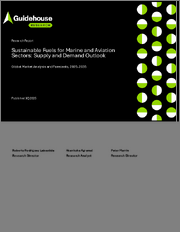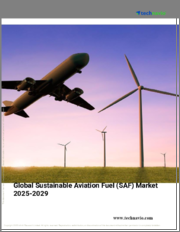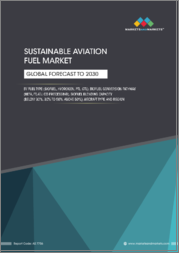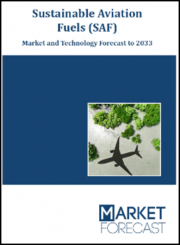
|
시장보고서
상품코드
1817388
선박 및 항공 부문용 지속가능 연료 : 수요와 공급 전망Sustainable Fuels for Marine and Aviation Sectors - Demand and Supply Outlook: Global Market Analysis and Forecasts, 2025-2035 |
||||||
지속가능 항공 연료(SAF)와 선박 연료(SMF) 시장은 첨단 연료 기술, 진화하는 규제 프레임워크, 항공 및 해운 부문의 변화하는 수요 역학 등의 융합으로 정의됩니다. SAF와 SMF는 상업화 초기 단계에 있지만, 두 가지 모두 장거리 운송의 탈탄소화를 실현하는 중요한 수단으로 점점 더 많이 인식되고 있습니다. 인수량 증가, 인프라 투자, 수명주기 배출 기준 등에 힘입어 이들 연료는 탈탄소화가 어려운 운송 부문의 에너지 전환에서 핵심적인 역할을 할 것으로 보입니다.
이 보고서는 SAF 및 SMF 시장 성장 촉진요인 및 장벽에 대한 개요를 제공하고, 이해관계자를 위한제안, 2025-2035년까지 지역별 및 경로별 지속가능 연료 시장의 전 세계 공급 및 수요를 전망합니다. SAF와 SMF의 발전을 촉진하는 주요 기술 경로를 분석합니다. SAF는 수소화 에스테르 및 지방산, 알코올에서 제트 연료, 전력에서 액체 연료, 피셔 트롭쉬 합성 파라핀 케로신 등 상업적, 전략적으로 관련성이 높은 4가지 전환 기술에 초점을 맞추었습니다. SMF 분석은 재생 메탄올, 재생 메탄, 그린 암모니아, 바이오연료(FAME 및 HVO 포함)를 대상으로 합니다.
목차
제1장 개요
- 서론
- 범위
- 시장 촉진요인
- 시장 억제요인
- 세계 시장 전망
제2장 시장의 문제
- 기술 개요
- SAF 패스웨이
- SAF 원료 평가
- SMF 패스웨이
- 촉진요인
- SAF 촉진요인
- SMF 촉진요인
- 억제요인
- SAF 억제요인
- SMF 억제요인
제3장 산업 밸류체인
- 경쟁 구도
- SAF
- SMF
제4장 시장 예측
- SAF
- SMF
제5장 결론·제안
- 3대 포인트
- 권장사항
- 정책 입안자와 규제기관
- 연료 생산자와 기술개발자
- 최종사용자
제6장 두자어와 약어 리스트
제7장 목차
제8장 도표
제9장 조사 범위, 정보원, 조사 방법 및 주석
KSA 25.09.26The sustainable aviation fuels (SAF) and sustainable marine fuels (SMF) markets are defined by the convergence of advanced fuel technologies, evolving regulatory frameworks, and shifting demand dynamics across aviation and shipping sectors. Although SAF and SMF are in the early stages of commercial deployment, both are increasingly recognized as critical enablers of long-distance transport decarbonization. Supported by growing offtake commitments, infrastructure investments, and lifecycle emissions standards, these fuels are positioned to play a central role in the energy transition for hard-to-abate transport sectors.
This Guidehouse Research report provides an overview of the drivers and barriers for the SAF and SMF market, offers recommendations for stakeholders, and projects global supply and demand for the sustainable fuels market by region and pathways from 2025 through 2035. It analyzes key technology pathways driving the development of SAF and SMF. SAF focuses on four commercially and strategically relevant conversion technologies: hydroprocessed esters and fatty acids, alcohol-to-jet, power-to-liquid, and Fischer-Tropsch synthetic paraffinic kerosene. The SMF analysis covers renewable methanol, renewable methane, green ammonia, and biofuels (including FAME and HVO).
Table of Contents
1. Executive Summary
- 1.1 Introduction
- 1.1.1 Scope
- 1.1.2 Market Drivers
- 1.1.3 Market Barriers
- 1.2 Global Market Outlook
2. Market Issues
- 2.1 Technology Overview
- 2.1.1 SAF Pathways
- 2.1.1.1 HEFA
- 2.1.1.2 AtJ
- 2.1.1.3 FT-SPK
- 2.1.1.4 PtL
- 2.1.1.5 Other Technologies
- 2.1.2 SAF Feedstock Assessment
- 2.1.3 SMF Pathways
- 2.1.3.1 Renewable Methanol
- 2.1.3.2 Renewable Methane
- 2.1.3.3 HVO
- 2.1.3.4 FAME
- 2.1.3.5 Green Ammonia
- 2.1.3.6 Other Technologies
- 2.1.1 SAF Pathways
- 2.2 Drivers
- 2.2.1 SAF Drivers
- 2.2.1.1 Airline and Corporate Demand for SAF as a Decarbonization Lever
- 2.2.1.2 Supply Chain Innovation and Feedstock Diversification
- 2.2.1.3 Policy Incentives and Global Initiatives
- 2.2.1.3.1 North America
- 2.2.1.3.2 Europe
- 2.2.1.3.3 Asia-Pacific
- 2.2.1.3.4 Latin America
- 2.2.1.3.5 Middle East & Africa
- 2.2.2 SMF Drivers
- 2.2.2.1 ESG Integration and Climate-Aligned Finance
- 2.2.2.2 Life Cycle Emissions Reduction and Infrastructure Compatibility
- 2.2.2.3 Supply Chain Decarbonization and Shipper Demand
- 2.2.2.4 Port-Led Ecosystem Development
- 2.2.2.5 Technology Maturity and Operational Flexibility
- 2.2.2.6 Policy Incentives and Global Initiatives
- 2.2.2.6.1 North America
- 2.2.2.6.2 Europe
- 2.2.2.6.3 Asia-Pacific
- 2.2.2.6.4 Latin America
- 2.2.2.6.5 Middle East & Africa
- 2.2.1 SAF Drivers
- 2.3 Barriers
- 2.3.1 SAF Barriers
- 2.3.1.1 Economic Viability and Feedstock Constraints
- 2.3.1.2 Demand Uncertainty and Financing Barriers
- 2.3.1.3 Infrastructure and Logistics Limitations
- 2.3.1.4 Technology Maturity and Scale-Up Risk
- 2.3.1.5 Market Fragmentation and Lack of Standards
- 2.3.2 SMF Barriers
- 2.3.2.1 Cost Premiums and Infrastructure Deficits
- 2.3.2.2 Regulatory Fragmentation and Uncertainty
- 2.3.2.3 Limited Fuel Supply and Cross-Sector Competition
- 2.3.2.4 Technology Maturity and Safety Risks
- 2.3.2.5 Investment Risk and Fleet Transition Hesitancy
- 2.3.2.6 Capacity and Equity Challenges in Developing Regions
- 2.3.1 SAF Barriers
3. Industry Value Chain
- 3.1 Competitive Landscape
- 3.1.1 SAF
- 3.1.1.1 Offtake Agreements for SAF
- 3.1.2 SMF
- 3.1.1 SAF
4. Market Forecasts
- 4.1 SAF
- 4.1.1 Scope
- 4.1.2 Methodology
- 4.1.3 Supply Capacity
- 4.1.3.1 Baseline Scenario
- 4.1.3.2 Conservative Scenario
- 4.1.3.3 Aggressive Scenario
- 4.1.4 Demand
- 4.2 SMF
- 4.2.1 Scope
- 4.2.2 Methodology
- 4.2.3 Supply Capacity
- 4.2.3.1 Baseline Scenario
- 4.2.3.2 Conservative Scenario
- 4.2.3.3 Aggressive Scenario
- 4.2.4 Demand
5. Conclusions and Recommendations
- 5.1 Three Big Takeaways
- 5.2 Recommendations
- 5.2.1 Policymakers and Regulators
- 5.2.2 Fuel Producers and Technology Developers
- 5.2.3 End Users



















